1999 SUBARU LEGACY Coolant system
[x] Cancel search: Coolant systemPage 132 of 1456

2. Engine Noise
Type of sound Condition Possible cause
Regular clicking soundSound increases as engine
speed increases.IValve mechanism is defective.
IIncorrect valve clearance
IWorn valve rocker
IWorn camshaft
IBroken valve spring
Heavy and dull clankOil pressure is low.IWorn crankshaft main bearing
IWorn connecting rod bearing (big end)
Oil pressure is normal.ILoose flywheel mounting bolts
IDamaged engine mounting
High-pitched clank
(Spark knock)Sound is noticeable when
accelerating with an overload.IIgnition timing advanced
IAccumulation of carbon inside combustion chamber
IWrong spark plug
IImproper gasoline
Clank when engine speed is
medium (1,000 to 2,000 rpm)Sound is reduced when fuel
injector connector of noisy cyl-
inder is disconnected.
(NOTE*)IWorn crankshaft main bearing
IWorn bearing at crankshaft end of connecting rod
Knocking sound when engine
is operating under idling speed
and engine is warmSound is reduced when fuel
injector connector of noisy cyl-
inder is disconnected.
(NOTE*)IWorn cylinder liner and piston ring
IBroken or stuck piston ring
IWorn piston pin and hole at piston end of connecting rod
Sound is not reduced if each
fuel injector connector is dis-
connected in turn. (NOTE*)IUnusually worn valve lifter
IWorn cam gear
IWorn camshaft journal bore in crankcase
Squeaky sound ÐIInsufficient generator lubrication
Rubbing sound ÐIDefective generator brush and rotor contact
Gear scream when starting
engineÐIDefective ignition starter switch
IWorn gear and starter pinion
Sound like polishing glass with
a dry clothÐILoose drive belt
IDefective engine coolant pump shaft
Hissing sound ÐILoss of compression
IAir leakage in air intake system, hoses, connections or
manifolds
Timing belt noise ÐILoose timing belt
IBelt contacting case/adjacent part
Valve tappet noise ÐIIncorrect valve clearance
NOTE*:
When disconnecting fuel injector connector, Malfunction Indicator Light (CHECK ENGINE light) illuminates and trouble code is
stored in ECM memory.
Therefore, carry out the CLEAR MEMORY MODE
necting fuel injector connector.
78
2-3a[K200]DIAGNOSTICS
2. Engine Noise
Page 207 of 1456
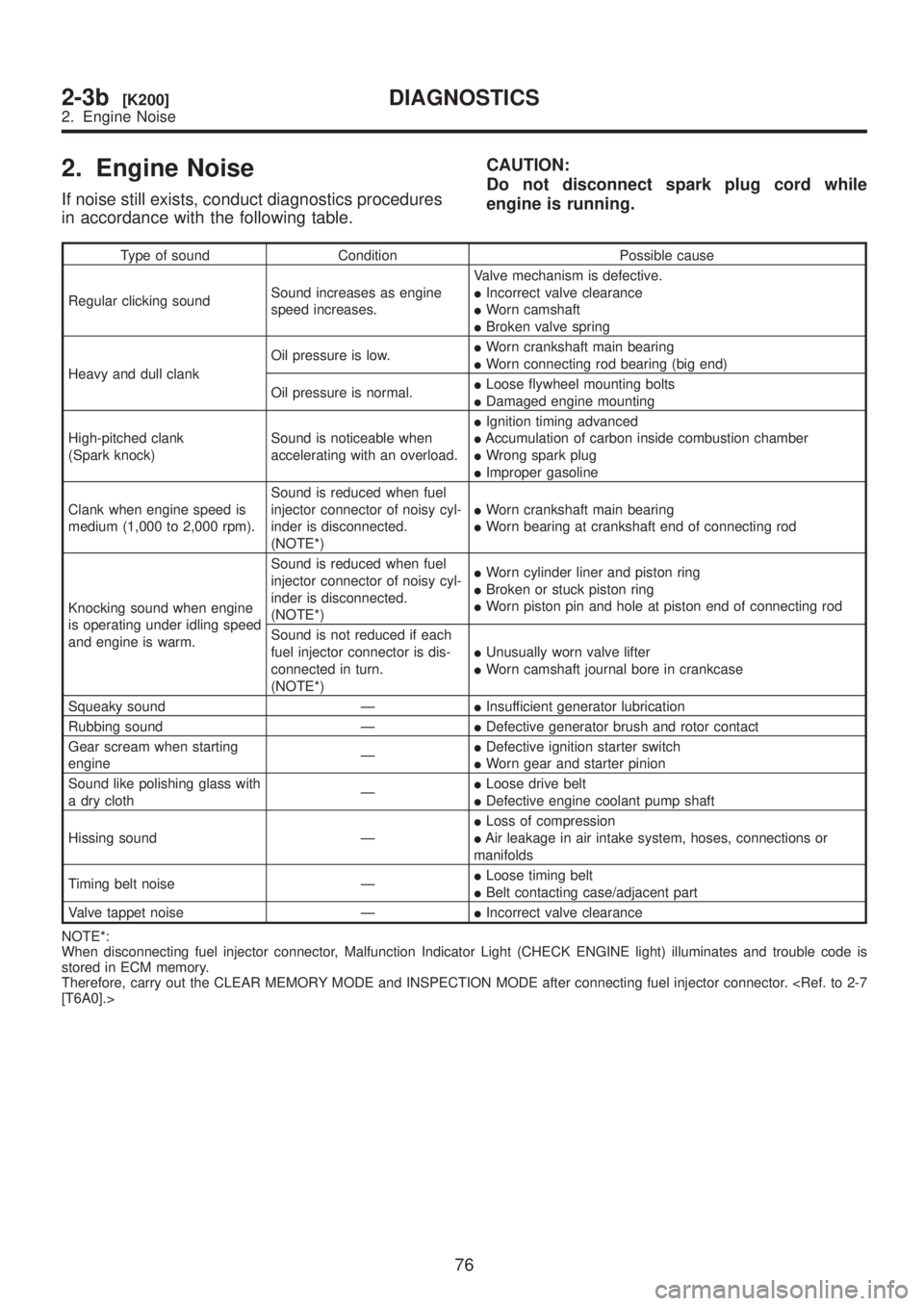
2. Engine Noise
If noise still exists, conduct diagnostics procedures
in accordance with the following table.CAUTION:
Do not disconnect spark plug cord while
engine is running.
Type of sound Condition Possible cause
Regular clicking soundSound increases as engine
speed increases.Valve mechanism is defective.
IIncorrect valve clearance
IWorn camshaft
IBroken valve spring
Heavy and dull clankOil pressure is low.IWorn crankshaft main bearing
IWorn connecting rod bearing (big end)
Oil pressure is normal.ILoose flywheel mounting bolts
IDamaged engine mounting
High-pitched clank
(Spark knock)Sound is noticeable when
accelerating with an overload.IIgnition timing advanced
IAccumulation of carbon inside combustion chamber
IWrong spark plug
IImproper gasoline
Clank when engine speed is
medium (1,000 to 2,000 rpm).Sound is reduced when fuel
injector connector of noisy cyl-
inder is disconnected.
(NOTE*)IWorn crankshaft main bearing
IWorn bearing at crankshaft end of connecting rod
Knocking sound when engine
is operating under idling speed
and engine is warm.Sound is reduced when fuel
injector connector of noisy cyl-
inder is disconnected.
(NOTE*)IWorn cylinder liner and piston ring
IBroken or stuck piston ring
IWorn piston pin and hole at piston end of connecting rod
Sound is not reduced if each
fuel injector connector is dis-
connected in turn.
(NOTE*)IUnusually worn valve lifter
IWorn camshaft journal bore in crankcase
Squeaky sound ÐIInsufficient generator lubrication
Rubbing sound ÐIDefective generator brush and rotor contact
Gear scream when starting
engineÐIDefective ignition starter switch
IWorn gear and starter pinion
Sound like polishing glass with
a dry clothÐILoose drive belt
IDefective engine coolant pump shaft
Hissing sound ÐILoss of compression
IAir leakage in air intake system, hoses, connections or
manifolds
Timing belt noise ÐILoose timing belt
IBelt contacting case/adjacent part
Valve tappet noise ÐIIncorrect valve clearance
NOTE*:
When disconnecting fuel injector connector, Malfunction Indicator Light (CHECK ENGINE light) illuminates and trouble code is
stored in ECM memory.
Therefore, carry out the CLEAR MEMORY MODE and INSPECTION MODE after connecting fuel injector connector.
76
2-3b[K200]DIAGNOSTICS
2. Engine Noise
Page 229 of 1456
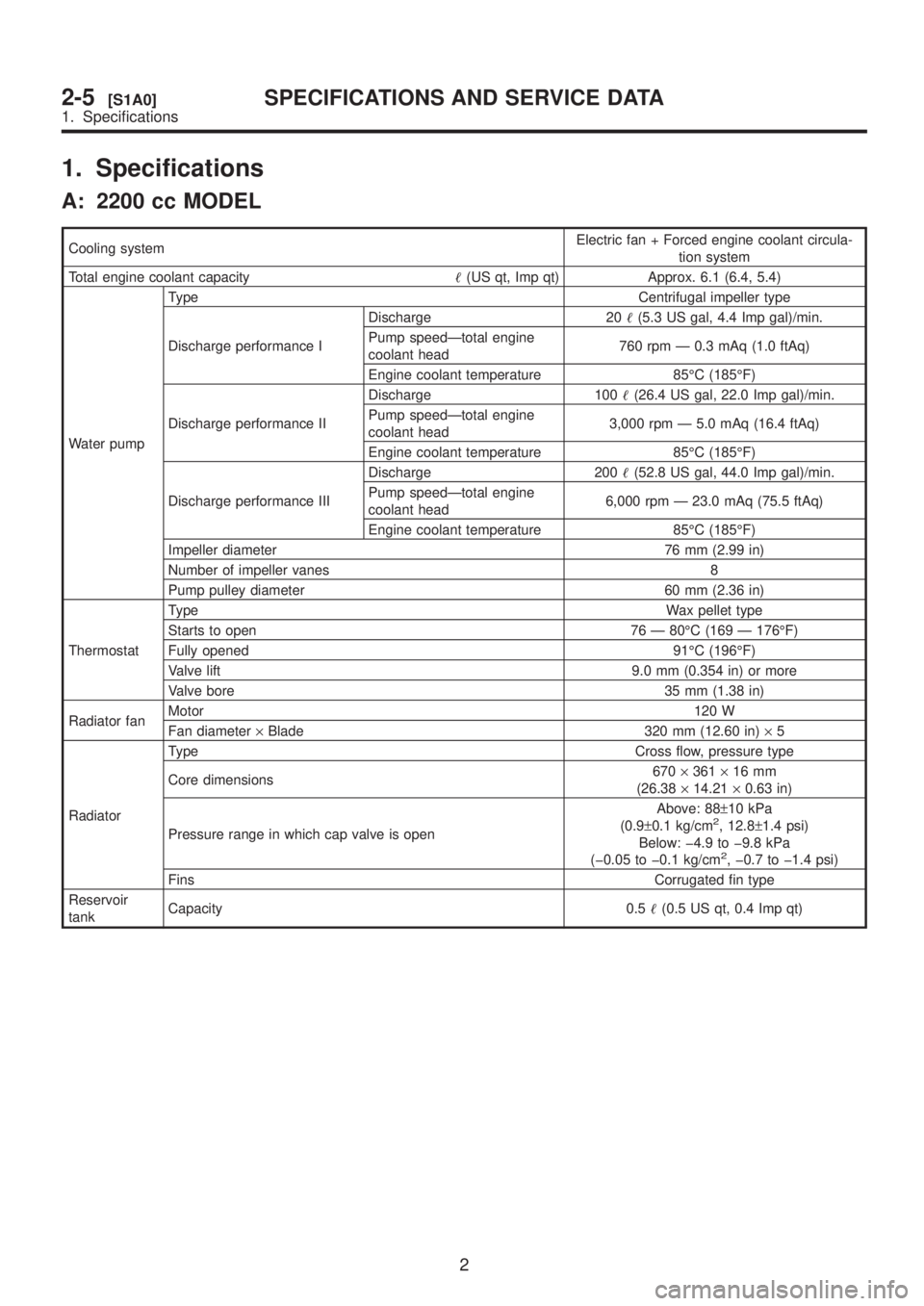
1. Specifications
A: 2200 cc MODEL
Cooling systemElectric fan + Forced engine coolant circula-
tion system
Total engine coolant capacity(US qt, Imp qt) Approx. 6.1 (6.4, 5.4)
Water pumpType Centrifugal impeller type
Discharge performance IDischarge 20(5.3 US gal, 4.4 Imp gal)/min.
Pump speedÐtotal engine
coolant head760 rpm Ð 0.3 mAq (1.0 ftAq)
Engine coolant temperature 85ÉC (185ÉF)
Discharge performance IIDischarge 100(26.4 US gal, 22.0 Imp gal)/min.
Pump speedÐtotal engine
coolant head3,000 rpm Ð 5.0 mAq (16.4 ftAq)
Engine coolant temperature 85ÉC (185ÉF)
Discharge performance IIIDischarge 200(52.8 US gal, 44.0 Imp gal)/min.
Pump speedÐtotal engine
coolant head6,000 rpm Ð 23.0 mAq (75.5 ftAq)
Engine coolant temperature 85ÉC (185ÉF)
Impeller diameter 76 mm (2.99 in)
Number of impeller vanes 8
Pump pulley diameter 60 mm (2.36 in)
ThermostatTypeWax pellet type
Starts to open 76 Ð 80ÉC (169 Ð 176ÉF)
Fully opened 91ÉC (196ÉF)
Valve lift 9.0 mm (0.354 in) or more
Valve bore 35 mm (1.38 in)
Radiator fanMotor120 W
Fan diameter´Blade 320 mm (12.60 in)´5
RadiatorType Cross flow, pressure type
Core dimensions670´361´16 mm
(26.38´14.21´0.63 in)
Pressure range in which cap valve is openAbove: 88±10 kPa
(0.9±0.1 kg/cm
2, 12.8±1.4 psi)
Below: þ4.9 to þ9.8 kPa
(þ0.05 to þ0.1 kg/cm
2, þ0.7 to þ1.4 psi)
FinsCorrugated fin type
Reservoir
tankCapacity 0.5(0.5 US qt, 0.4 Imp qt)
2
2-5[S1A0]SPECIFICATIONS AND SERVICE DATA
1. Specifications
Page 230 of 1456

B: 2500 cc MODEL
Cooling systemElectric fan + Forced engine coolant circula-
tion system
Total engine coolant capacity(US qt, Imp qt) Approx. 6.1 (6.4, 5.4)
Water pumpType Centrifugal impeller type
Discharge performance IDischarge 20(5.3 US gal, 4.4 Imp gal)/min.
Pump speedÐtotal engine
coolant head760 rpm Ð 0.3 mAq (1.0 ftAq)
Engine coolant temperature 85ÉC (185ÉF)
Discharge performance IIDischarge 100(26.4 US gal, 22.0 Imp gal)/min.
Pump speedÐtotal engine
coolant head3,000 rpm Ð 5.0 mAq (16.4 ftAq)
Engine coolant temperature 85ÉC (185ÉF)
Discharge performance IIIDischarge 200(52.8 US gal, 44.0 Imp gal)/min.
Pump speedÐtotal engine
coolant head6,000 rpm Ð 23.0 mAq (75.5 ftAq)
Engine coolant temperature 85ÉC (185ÉF)
Impeller diameter 76 mm (2.99 in)
Number of impeller vanes 8
Pump pulley diameter 60 mm (2.36 in)
ThermostatTypeWax pellet type
Starts to open 76 Ð 80ÉC (169 Ð 176ÉF)
Fully opened 91ÉC (196ÉF)
Valve lift 9.0 mm (0.354 in) or more
Valve bore 35 mm (1.38 in)
Radiator fanMotor120 W (main fan)
140 W (sub fan)
Fan diameter´Blade340 mm (13.39 in)´5 (main fan)
280 mm (11.02 in)´4 (sub fan)
RadiatorType Cross flow, pressure type
Core dimensions670´361´16 mm
(26.38´14.21´0.63 in)
Pressure range in which cap valve is openAbove: 88±10 kPa
(0.9±0.1 kg/cm
2, 12.8±1.4 psi)
Below: þ4.9 to þ9.8 kPa
(þ0.05 to þ0.1 kg/cm
2, þ0.7 to þ1.4 psi)
FinsCorrugated fin type
Reservoir
tankCapacity 0.5(0.5 US qt, 0.4 Imp qt)
2. Service Data
Water pump
Clearance between impeller and caseStandard0.5 Ð 0.7 mm (0.020 Ð 0.028
in)
Limit 1.0 mm (0.039 in)
ªThrustº runout of impeller end 0.5 mm (0.020 in)
3
[S200]2-5SPECIFICATIONS AND SERVICE DATA
2. Service Data
Page 231 of 1456
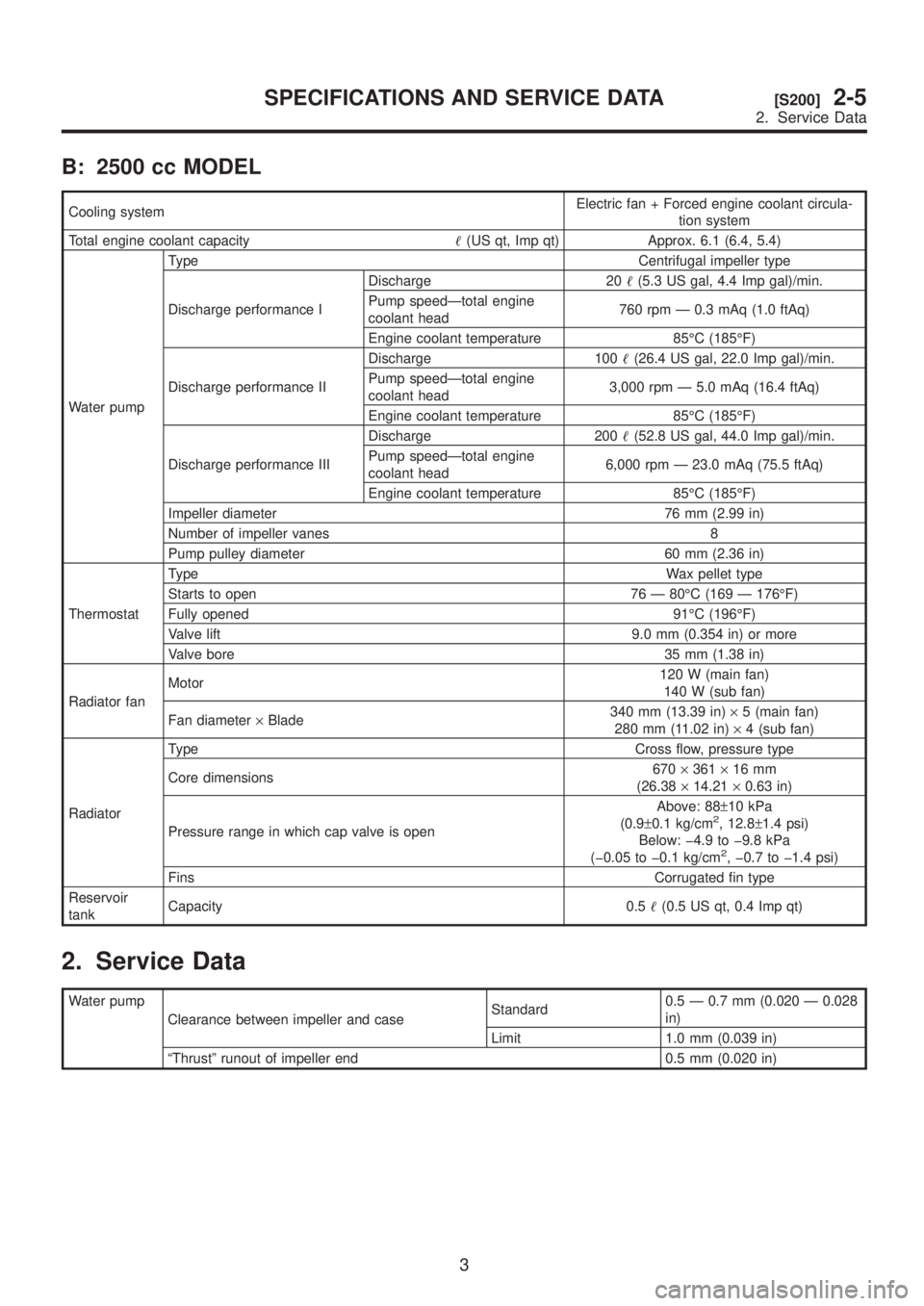
B: 2500 cc MODEL
Cooling systemElectric fan + Forced engine coolant circula-
tion system
Total engine coolant capacity(US qt, Imp qt) Approx. 6.1 (6.4, 5.4)
Water pumpType Centrifugal impeller type
Discharge performance IDischarge 20(5.3 US gal, 4.4 Imp gal)/min.
Pump speedÐtotal engine
coolant head760 rpm Ð 0.3 mAq (1.0 ftAq)
Engine coolant temperature 85ÉC (185ÉF)
Discharge performance IIDischarge 100(26.4 US gal, 22.0 Imp gal)/min.
Pump speedÐtotal engine
coolant head3,000 rpm Ð 5.0 mAq (16.4 ftAq)
Engine coolant temperature 85ÉC (185ÉF)
Discharge performance IIIDischarge 200(52.8 US gal, 44.0 Imp gal)/min.
Pump speedÐtotal engine
coolant head6,000 rpm Ð 23.0 mAq (75.5 ftAq)
Engine coolant temperature 85ÉC (185ÉF)
Impeller diameter 76 mm (2.99 in)
Number of impeller vanes 8
Pump pulley diameter 60 mm (2.36 in)
ThermostatTypeWax pellet type
Starts to open 76 Ð 80ÉC (169 Ð 176ÉF)
Fully opened 91ÉC (196ÉF)
Valve lift 9.0 mm (0.354 in) or more
Valve bore 35 mm (1.38 in)
Radiator fanMotor120 W (main fan)
140 W (sub fan)
Fan diameter´Blade340 mm (13.39 in)´5 (main fan)
280 mm (11.02 in)´4 (sub fan)
RadiatorType Cross flow, pressure type
Core dimensions670´361´16 mm
(26.38´14.21´0.63 in)
Pressure range in which cap valve is openAbove: 88±10 kPa
(0.9±0.1 kg/cm
2, 12.8±1.4 psi)
Below: þ4.9 to þ9.8 kPa
(þ0.05 to þ0.1 kg/cm
2, þ0.7 to þ1.4 psi)
FinsCorrugated fin type
Reservoir
tankCapacity 0.5(0.5 US qt, 0.4 Imp qt)
2. Service Data
Water pump
Clearance between impeller and caseStandard0.5 Ð 0.7 mm (0.020 Ð 0.028
in)
Limit 1.0 mm (0.039 in)
ªThrustº runout of impeller end 0.5 mm (0.020 in)
3
[S200]2-5SPECIFICATIONS AND SERVICE DATA
2. Service Data
Page 236 of 1456
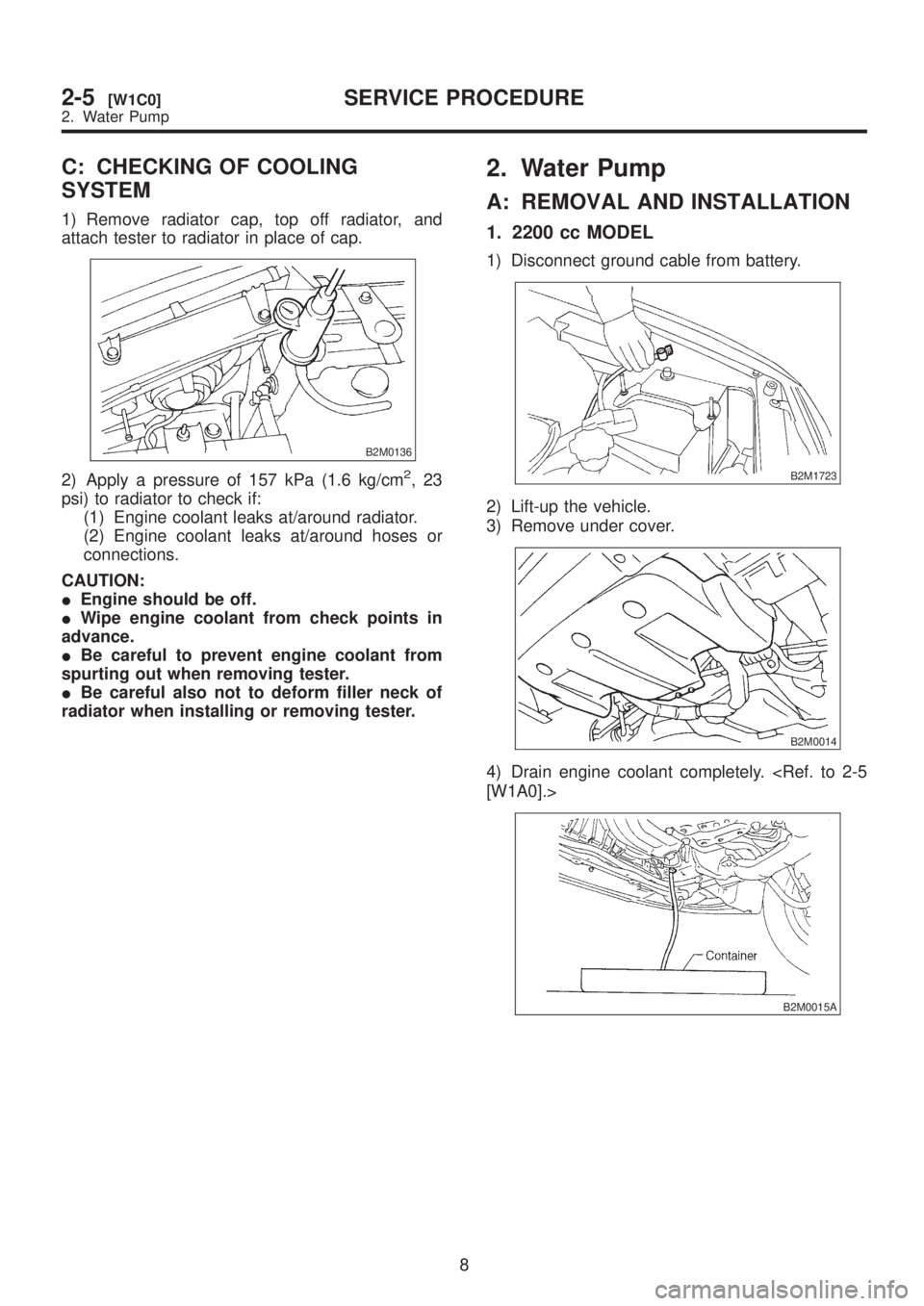
C: CHECKING OF COOLING
SYSTEM
1) Remove radiator cap, top off radiator, and
attach tester to radiator in place of cap.
B2M0136
2) Apply a pressure of 157 kPa (1.6 kg/cm2,23
psi) to radiator to check if:
(1) Engine coolant leaks at/around radiator.
(2) Engine coolant leaks at/around hoses or
connections.
CAUTION:
IEngine should be off.
IWipe engine coolant from check points in
advance.
IBe careful to prevent engine coolant from
spurting out when removing tester.
IBe careful also not to deform filler neck of
radiator when installing or removing tester.
2. Water Pump
A: REMOVAL AND INSTALLATION
1. 2200 cc MODEL
1) Disconnect ground cable from battery.
B2M1723
2) Lift-up the vehicle.
3) Remove under cover.
B2M0014
4) Drain engine coolant completely.
B2M0015A
8
2-5[W1C0]SERVICE PROCEDURE
2. Water Pump
Page 237 of 1456
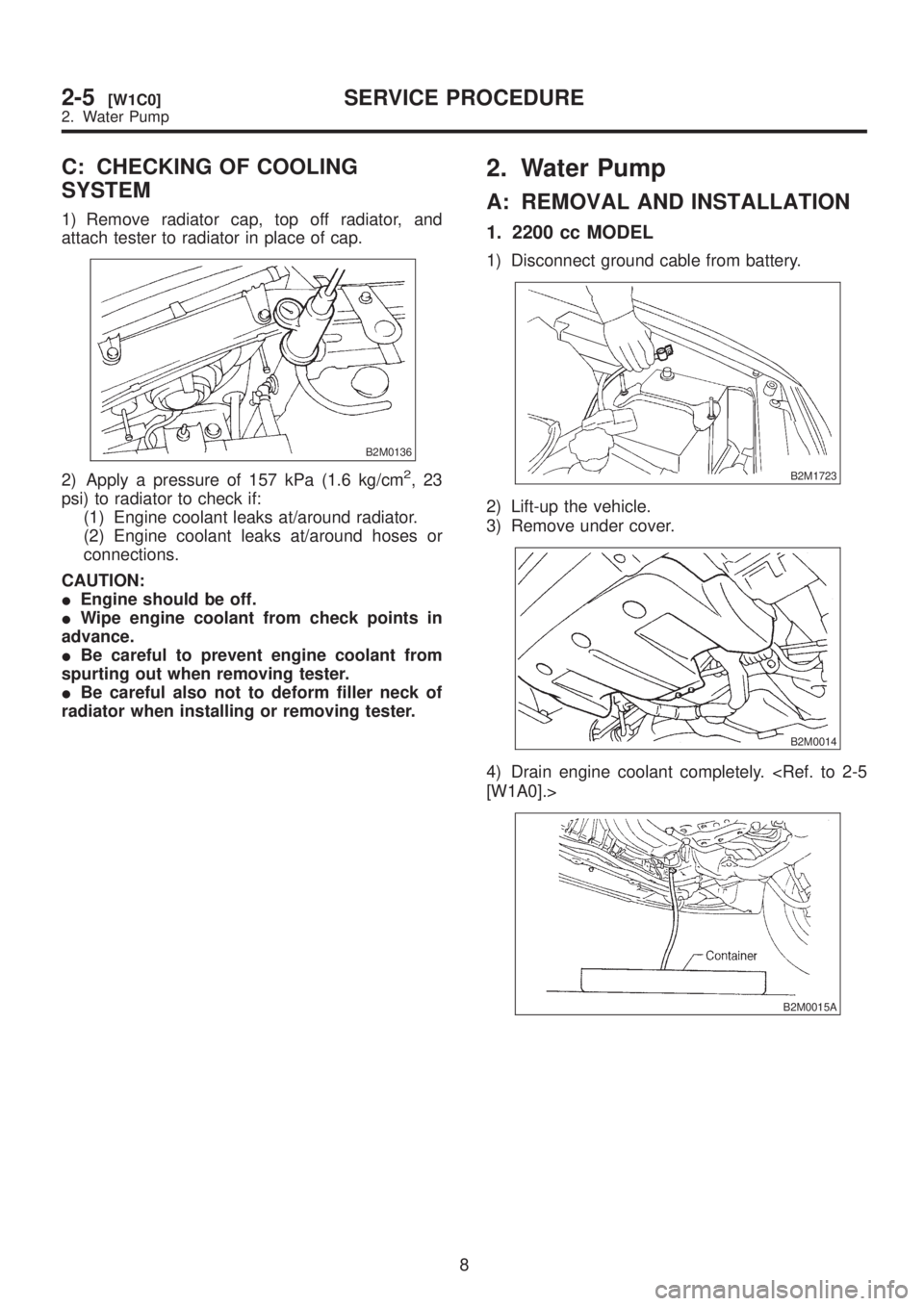
C: CHECKING OF COOLING
SYSTEM
1) Remove radiator cap, top off radiator, and
attach tester to radiator in place of cap.
B2M0136
2) Apply a pressure of 157 kPa (1.6 kg/cm2,23
psi) to radiator to check if:
(1) Engine coolant leaks at/around radiator.
(2) Engine coolant leaks at/around hoses or
connections.
CAUTION:
IEngine should be off.
IWipe engine coolant from check points in
advance.
IBe careful to prevent engine coolant from
spurting out when removing tester.
IBe careful also not to deform filler neck of
radiator when installing or removing tester.
2. Water Pump
A: REMOVAL AND INSTALLATION
1. 2200 cc MODEL
1) Disconnect ground cable from battery.
B2M1723
2) Lift-up the vehicle.
3) Remove under cover.
B2M0014
4) Drain engine coolant completely.
B2M0015A
8
2-5[W1C0]SERVICE PROCEDURE
2. Water Pump
Page 260 of 1456

1. Engine Cooling System Trouble in General
TroubleCorrective action
Over-heatinga. Insufficient engine coolantReplenish engine coolant, inspect for leakage, and
repair.
b. Loose timing belt Repair or replace timing belt tensioner.
c. Oil on drive belt Replace.
d. Malfunction of thermostat Replace.
e. Malfunction of water pump Replace.
f. Clogged engine coolant passage Clean.
g. Improper ignition timingInspect and repair ignition control system.
h. Clogged or leaking radiator Clean or repair, or replace.
i. Improper engine oil in engine coolant Replace engine coolant.
j. Air/fuel mixture ratio too leanInspect and repair fuel injection system.
k. Excessive back pressure in exhaust system Clean or replace.
l. Insufficient clearance between piston and cylinder Adjust or replace.
m. Slipping clutch Repair or replace.
n. Dragging brake Adjust.
o. Improper transmission oil Replace.
p. Defective thermostat Replace.
q. Malfunction of electric fanInspect radiator fan relay, engine coolant temperature
sensor or radiator motor and replace there.
Over-coolinga. Atmospheric temperature extremely low Partly cover radiator front area.
b. Defective thermostat Replace.
Engine coolant
leaks.a. Loosened or damaged connecting units on
hosesRepair or replace.
b. Leakage from water pump Replace.
c. Leakage from water pipe Repair or replace.
d. Leakage around cylinder head gasket Retighten cylinder head bolts or replace gasket.
e. Damaged or cracked cylinder head and crank-
caseRepair or replace.
f. Damaged or cracked thermostat case Repair or replace.
g. Leakage from radiator Repair or replace.
Noisea. Defective drive belt Replace.
b. Defective radiator fan Replace.
c. Defective water pump bearing Replace water pump.
d. Defective water pump mechanical seal Replace water pump.
26
2-5[K100]DIAGNOSTICS
1. Engine Cooling System Trouble in General